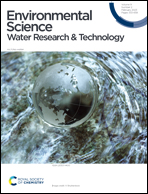Membrane degassing with the combination of sweep gas and vacuum pressure for ammonia removal†
Abstract
Membrane degassing has recently been gaining attention as an ammonia treatment process. Among the various types, the adsorption solution flow type is the most commonly used as a membrane degassing process for ammonia. However, the adsorption solution flow type has a critical drawback including continuous consumption of high concentration of acid. As alternatives, there are sweep gas type and vacuum type, but they have been used limitedly for ammonia treatment due to low degassing performance. In this study, a membrane degassing technology with sweep gas and vacuum pressure hybrid type is proposed as an ammonia treatment process. The average ammonia degassing flux and average ammonia removal ratio were evaluated as parameters of degassing performance. In addition, the apparent ammonia mass transfer coefficient (k) was calculated and compared with the values reported in previous studies. Preliminary results showed an average ammonia degassing flux of 17 mg NH3 per m2 min−1 for 6 h and achieved an average ammonia removal ratio of 95.5%. The k value was about 2.03 × 103 m h−1, exhibiting similar or even higher results than the adsorption solution flow type reported previously. Considering that the use of acid is excluded as well as the excellent degassing performance, the results of this study suggest high potential of employing combination of sweep gas and vacuum pressure as a suitable membrane degassing process that can be effectively utilized for ammonia separation.



 Please wait while we load your content...
Please wait while we load your content...